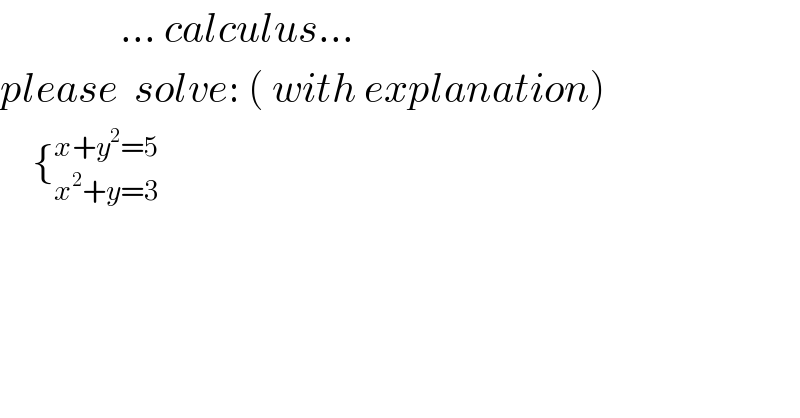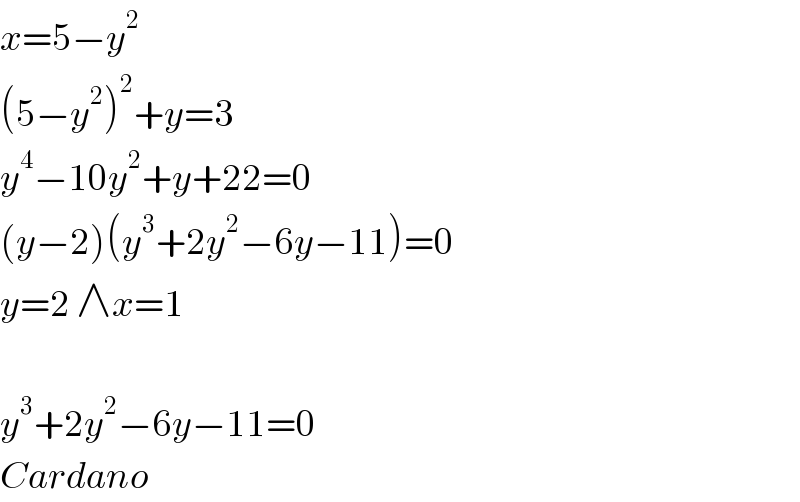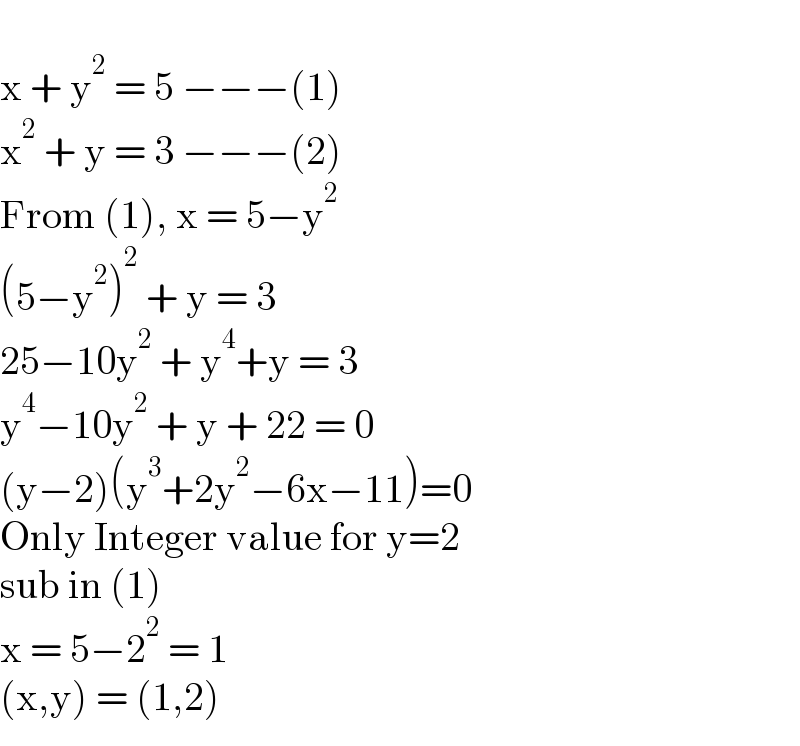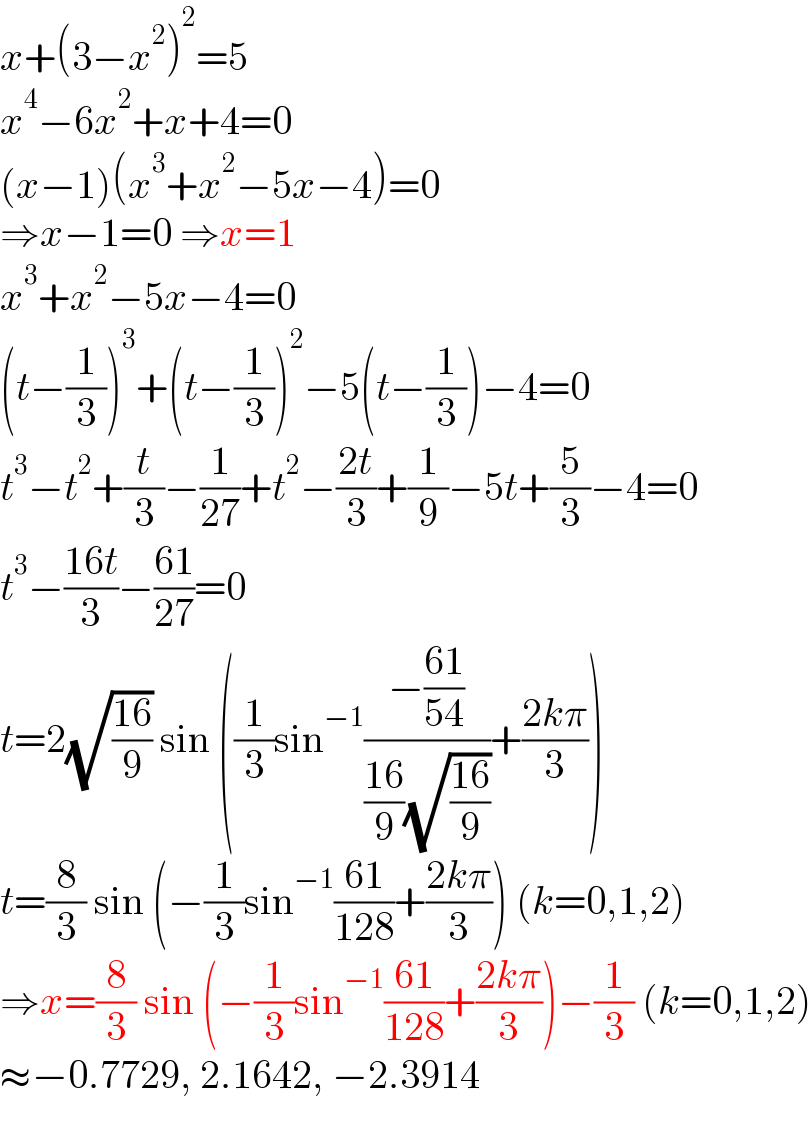
Question Number 126887 by mnjuly1970 last updated on 25/Dec/20

$$\:\:\:\:\:\:\:\:\:\:\:\:\:\:\:...\:{calculus}... \\ $$$${please}\:\:{solve}:\:\left(\:{with}\:{explanation}\right) \\ $$$$\:\:\:\:\left\{_{{x}^{\mathrm{2}} +{y}=\mathrm{3}} ^{{x}+{y}^{\mathrm{2}} =\mathrm{5}} \right. \\ $$$$ \\ $$
Commented by Lordose last updated on 25/Dec/20

$$\mathrm{I}\:\mathrm{don}'\mathrm{t}\:\mathrm{know}\:\mathrm{a}\:\mathrm{calculus}\:\mathrm{approach}\:\mathrm{though} \\ $$
Commented by bramlexs22 last updated on 25/Dec/20

$${x}=\mathrm{5}−{y}^{\mathrm{2}} \\ $$$$\left(\mathrm{5}−{y}^{\mathrm{2}} \right)^{\mathrm{2}} +{y}=\mathrm{3} \\ $$$${y}^{\mathrm{4}} −\mathrm{10}{y}^{\mathrm{2}} +{y}+\mathrm{22}=\mathrm{0} \\ $$$$\left({y}−\mathrm{2}\right)\left({y}^{\mathrm{3}} +\mathrm{2}{y}^{\mathrm{2}} −\mathrm{6}{y}−\mathrm{11}\right)=\mathrm{0} \\ $$$${y}=\mathrm{2}\:\wedge{x}=\mathrm{1} \\ $$$$ \\ $$$${y}^{\mathrm{3}} +\mathrm{2}{y}^{\mathrm{2}} −\mathrm{6}{y}−\mathrm{11}=\mathrm{0} \\ $$$${Cardano} \\ $$
Answered by Lordose last updated on 25/Dec/20

$$ \\ $$$$\mathrm{x}\:+\:\mathrm{y}^{\mathrm{2}} \:=\:\mathrm{5}\:−−−\left(\mathrm{1}\right) \\ $$$$\mathrm{x}^{\mathrm{2}} \:+\:\mathrm{y}\:=\:\mathrm{3}\:−−−\left(\mathrm{2}\right) \\ $$$$\mathrm{From}\:\left(\mathrm{1}\right),\:\mathrm{x}\:=\:\mathrm{5}−\mathrm{y}^{\mathrm{2}} \\ $$$$\left(\mathrm{5}−\mathrm{y}^{\mathrm{2}} \right)^{\mathrm{2}} \:+\:\mathrm{y}\:=\:\mathrm{3} \\ $$$$\mathrm{25}−\mathrm{10y}^{\mathrm{2}} \:+\:\mathrm{y}^{\mathrm{4}} +\mathrm{y}\:=\:\mathrm{3} \\ $$$$\mathrm{y}^{\mathrm{4}} −\mathrm{10y}^{\mathrm{2}} \:+\:\mathrm{y}\:+\:\mathrm{22}\:=\:\mathrm{0} \\ $$$$\left(\mathrm{y}−\mathrm{2}\right)\left(\mathrm{y}^{\mathrm{3}} +\mathrm{2y}^{\mathrm{2}} −\mathrm{6x}−\mathrm{11}\right)=\mathrm{0} \\ $$$$\mathrm{Only}\:\mathrm{Integer}\:\mathrm{value}\:\mathrm{for}\:\mathrm{y}=\mathrm{2} \\ $$$$\mathrm{sub}\:\mathrm{in}\:\left(\mathrm{1}\right) \\ $$$$\mathrm{x}\:=\:\mathrm{5}−\mathrm{2}^{\mathrm{2}} \:=\:\mathrm{1} \\ $$$$\left(\mathrm{x},\mathrm{y}\right)\:=\:\left(\mathrm{1},\mathrm{2}\right) \\ $$
Answered by mr W last updated on 25/Dec/20

$${x}+\left(\mathrm{3}−{x}^{\mathrm{2}} \right)^{\mathrm{2}} =\mathrm{5} \\ $$$${x}^{\mathrm{4}} −\mathrm{6}{x}^{\mathrm{2}} +{x}+\mathrm{4}=\mathrm{0} \\ $$$$\left({x}−\mathrm{1}\right)\left({x}^{\mathrm{3}} +{x}^{\mathrm{2}} −\mathrm{5}{x}−\mathrm{4}\right)=\mathrm{0} \\ $$$$\Rightarrow{x}−\mathrm{1}=\mathrm{0}\:\Rightarrow{x}=\mathrm{1} \\ $$$${x}^{\mathrm{3}} +{x}^{\mathrm{2}} −\mathrm{5}{x}−\mathrm{4}=\mathrm{0} \\ $$$$\left({t}−\frac{\mathrm{1}}{\mathrm{3}}\right)^{\mathrm{3}} +\left({t}−\frac{\mathrm{1}}{\mathrm{3}}\right)^{\mathrm{2}} −\mathrm{5}\left({t}−\frac{\mathrm{1}}{\mathrm{3}}\right)−\mathrm{4}=\mathrm{0} \\ $$$${t}^{\mathrm{3}} −{t}^{\mathrm{2}} +\frac{{t}}{\mathrm{3}}−\frac{\mathrm{1}}{\mathrm{27}}+{t}^{\mathrm{2}} −\frac{\mathrm{2}{t}}{\mathrm{3}}+\frac{\mathrm{1}}{\mathrm{9}}−\mathrm{5}{t}+\frac{\mathrm{5}}{\mathrm{3}}−\mathrm{4}=\mathrm{0} \\ $$$${t}^{\mathrm{3}} −\frac{\mathrm{16}{t}}{\mathrm{3}}−\frac{\mathrm{61}}{\mathrm{27}}=\mathrm{0} \\ $$$${t}=\mathrm{2}\sqrt{\frac{\mathrm{16}}{\mathrm{9}}}\:\mathrm{sin}\:\left(\frac{\mathrm{1}}{\mathrm{3}}\mathrm{sin}^{−\mathrm{1}} \frac{−\frac{\mathrm{61}}{\mathrm{54}}}{\frac{\mathrm{16}}{\mathrm{9}}\sqrt{\frac{\mathrm{16}}{\mathrm{9}}}}+\frac{\mathrm{2}{k}\pi}{\mathrm{3}}\right) \\ $$$${t}=\frac{\mathrm{8}}{\mathrm{3}}\:\mathrm{sin}\:\left(−\frac{\mathrm{1}}{\mathrm{3}}\mathrm{sin}^{−\mathrm{1}} \frac{\mathrm{61}}{\mathrm{128}}+\frac{\mathrm{2}{k}\pi}{\mathrm{3}}\right)\:\left({k}=\mathrm{0},\mathrm{1},\mathrm{2}\right) \\ $$$$\Rightarrow{x}=\frac{\mathrm{8}}{\mathrm{3}}\:\mathrm{sin}\:\left(−\frac{\mathrm{1}}{\mathrm{3}}\mathrm{sin}^{−\mathrm{1}} \frac{\mathrm{61}}{\mathrm{128}}+\frac{\mathrm{2}{k}\pi}{\mathrm{3}}\right)−\frac{\mathrm{1}}{\mathrm{3}}\:\left({k}=\mathrm{0},\mathrm{1},\mathrm{2}\right) \\ $$$$\approx−\mathrm{0}.\mathrm{7729},\:\mathrm{2}.\mathrm{1642},\:−\mathrm{2}.\mathrm{3914} \\ $$
